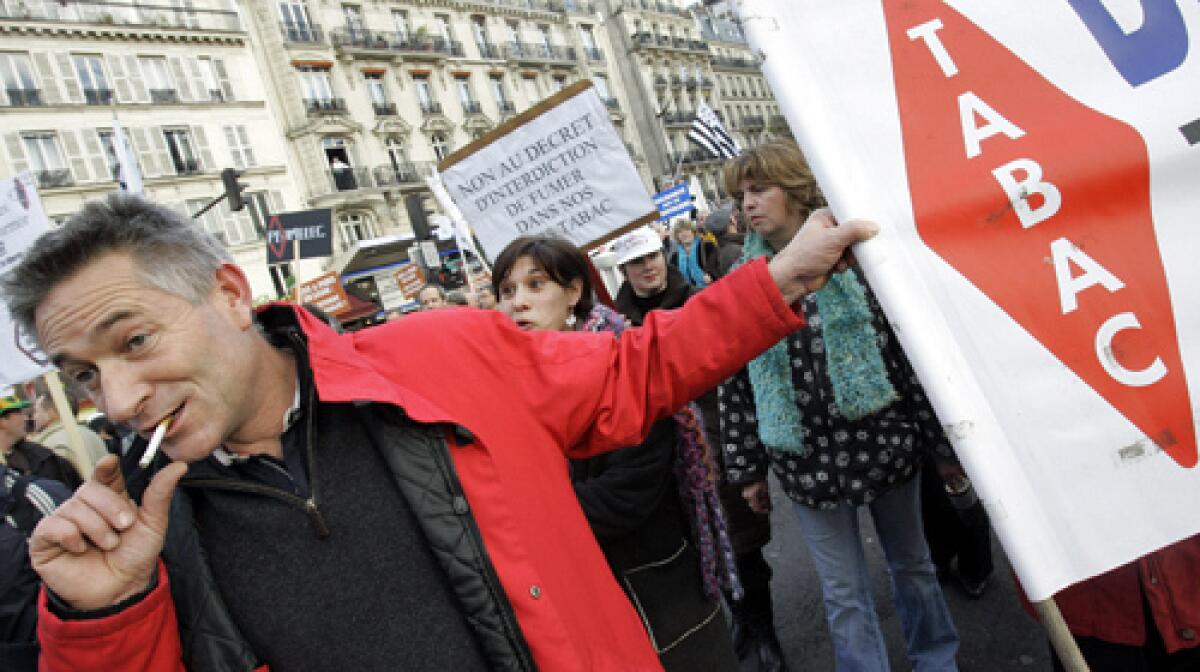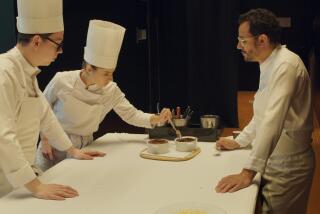Keeping a French tradition

Someone once noted that a sure sign of the passing of a cultural phenomenon is not its disappearance but its preservation, or sanctification, in a museum. And so it is now with smoking in France.
After I moved to Paris three years ago from Manhattan, where Mayor Michael R. Bloomberg doesn’t even let you eat artery-clogging cookies, never mind have a Marlboro, I couldn’t believe it when I read that only 24% of the French smoke, a figure roughly the same as in the U.S. How was it possible?
I decided that French smokers must be spread over a broader demographic than their American counterparts. Or else they all live in my new neighborhood.
Now, as the bell tolls for that Gitane being sucked, and energetically exhaled, by the person in the banquette alongside me, I have been trying to imagine Paris, the city of such legendary smokers as Jean-Paul Sartre, Jean-Paul Belmondo and Jean-Paul, my butcher, without its ubiquitous clouds of smoke.
The dawning of the new, improved smoke-free France is scheduled for Tuesday, when the last phase of a smoking ban goes into effect in all indoor public spaces, including bars, dance clubs and cafes.
Still, I was skeptical that the French would fall in line. So I turned to Le Musee du Fumeur.
In a city where eccentric little museums are thick on the ground, the Museum of Smoking somehow manages to be the only one in the funky but rapidly gentrifying 11th Arrondissement. Unless you count that collection of stuff about Edith Piaf in some old lady’s apartment.
I turned to this tiny storefront halfway between the Bastille and Pere Lachaise Cemetery (between liberty and death, as it were) for a bit of perspective on this momentous event. What I discovered was a personal vision rooted in scholarship, trying to position smoking as a noble, even sacred, activity.
With its ocher walls suggesting centuries of lingering tar, its Maya logo an homage to the divinity of smoking, its gift shop filled with bongs and self-help guides to quitting, and those no-smoking signs with a cigarette and a red line through it all over the place, le Musee du Fumeur is pretty schizoid.
Trading on the very French idea that anything they’ve done as a nation for so long must be worth serious attention, the museum’s curators embrace smoking as a worthy activity in all forms (except cigarettes, which they see as the “fast food” of smoking).
“People, when they come here, are able to see that tobacco use was noble, across the continents, that it was linked to a history and a culture, not just a public health disaster, that tobacco use can be seen in a civilized way, that we can smoke less and better,” curator Tigrane Hadengue says. “Yes, smoke less and better!”
This makes absolutely no sense to me, but he and his co-curator, Michka Seeliger-Chatelain, are so perfectly cast it’s hard not to be mesmerized. In her 60s with wisps of gray hair falling from her chignon, she has devoted much time to the study of the healing powers of many plants, including tobacco.
Tall, tanned and aristocratic in bearing, Hadengue, 37, professes himself most interested in a good cigar, accompanied by a good Bordeaux. In fact, he began as a collector of wine artifacts and then moved on to the paraphernalia of smoking.
Et voila, he soon had a museum filled with sepia-toned etchings of American Indians with pipes and cool photographs of famous smokers such as writer George Sand, whose tobacco habit became a symbol of emancipation for a generation of women.
Hadengue is worried that France, with its dedication to the beauties of theoretical purity, will root out smoking from the culture with every bit as much vehemence as it has long defended it. Already, cigarettes have been censoriously airbrushed out of photos of such celebrated French intellectuals as Andre Malraux, who appears cigarette-less on a postage stamp. Then there’s existential thinker Sartre, featured in a documentary in the new national library moving his hand to and from his mouth with nothing between his fingers.
“Smoking is an integral part of intellectual and philosophical culture in France,” Hadengue says. “After the smoking ban, what will happen to the cafe philo, the philosophical cafes where people get together and debate for hours?”
Yes, that is the formula reinforced by every beloved French movie and earnest novel of my youth. But surely such a cliche is a thing of the past; nobody has time to linger forever over a Cognac and cigarette in a cafe.
Then I moved to Paris. And stopped working.
After a few months, I learned that all the cliches are true. Everyone leaves Paris in August; the rest of the year, few match the work hours of their counterparts on the other side of the Atlantic; French families don’t spend Sundays shopping but rather linger over a long lunch -- and a smoke.
I began to wonder whether taking up smoking was a necessary part of the development of my Inner French Woman, which has been at battle with my Inner New York Woman since I relocated. (Really, they hate each other.) I could learn to cook, tie the scarf and read obscure Moroccan novels; I could have cheekbone implants and even blow a bit of air out of a curled lip to express disapproval. But without a cigarette, I just couldn’t imagine how to fake the proper French female self-possession.
One evening after I’d been to a dinner party, my 11-year-old daughter recoiled when I entered her room. “Mom, were you smoking tonight?” she asked, holding her nose. “You stink.”
I hadn’t been. But I had been at the home of the most effortlessly soignee Frenchwoman I know, who holds a cigarette between her slim flingers as if she were an iconic Horst image come to life. That evening she wore a close-cut velvet suit the color of a Cotes de Nuit, dark stockings and very high heels.
There were about a dozen people around the table in her dining room with its heavy drapes and glass display cabinets filled with 18th century china and, no kidding, an acrylic-encased business card of George Washington’s favorite Frenchman, the Marquis de Lafayette. (Madame’s husband is a distant relative.)
Wearing a clumsy French accent as embarrassing as my career-girl black suit, I was an American at a table of sleek, bookish French people. After many courses involving wine older than my teenage son, everyone lighted up.
As I closed my eyes and breathed slowly, I tried to commune with an earlier self -- the post-collegiate reporter living alone in swampy South Florida with my only companions the cigarettes from a box of Marlboros. They gave me dreams of Paris, the fantasies of a lonely girl, of books and cafes, broad boulevards and etched crystal, a Gauloise lighted and handed to me by a young man. . . .
But then, years of constructive programming got the better of me. And of course the science saying don’t do it got the better of me. Even the French aren’t immune. According to multiple surveys, obviously not taken at multiple-course dinner parties on the Left Bank, the vast majority support this no-exceptions ban.
Filmmakers, typically in the avant garde, are already with the program. The opening sequence of a recent film, “Paris Je T’aime,” the latest-edition lonely-girl fantasy about the City of Light, shows an elegant woman who meets an equally elegant fellow after she collapses on a Montmartre street. Why’d she faint? She’d just given up smoking. After comforting her in his car, the nice fellow offers to ferry our heroine to her next appointment.
It is with her tabacologue, the doctor who is helping her quit.
Special correspondent Rebecca Ruquist contributed to this report.
More to Read
Sign up for The Wild
We’ll help you find the best places to hike, bike and run, as well as the perfect silent spots for meditation and yoga.
You may occasionally receive promotional content from the Los Angeles Times.






